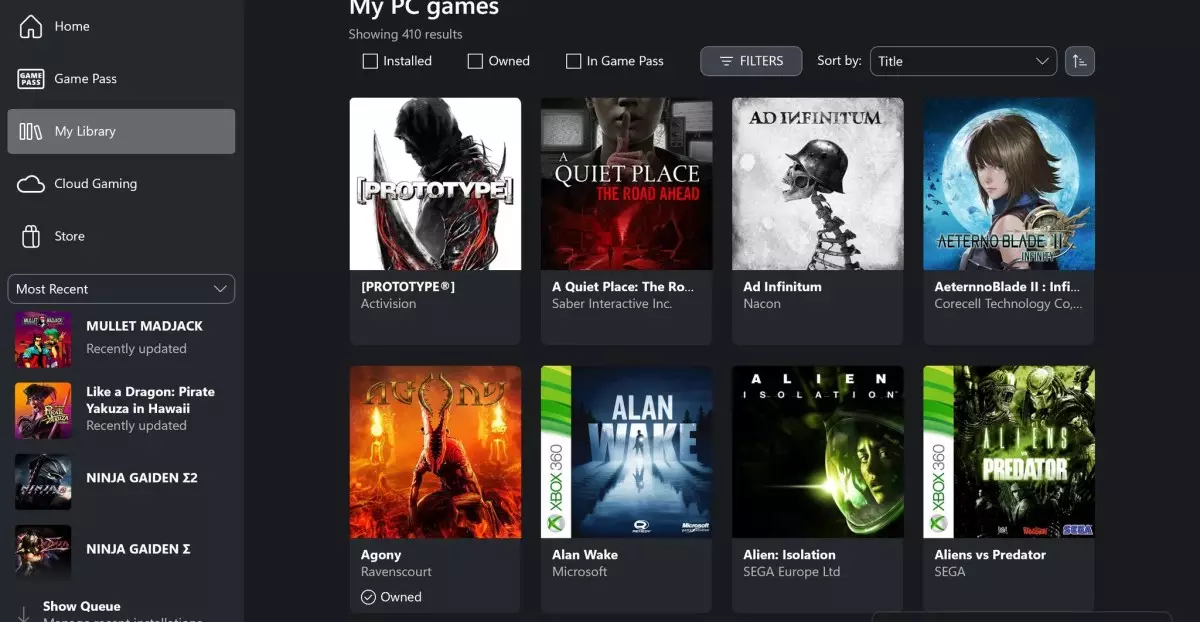Microsoft is on the verge of a significant transformation in the gaming landscape, aiming to dissolve the boundaries that have traditionally separated Xbox and Windows gaming experiences. These early signs hint at a broader strategy to create a cohesive ecosystem that interlinks the two platforms. As Tom Warren, an authority on Microsoft’s initiatives, highlighted, we are witnessing intriguing developments within the Xbox app on Windows. This shift isn’t just a glitch or a temporary anomaly; it’s the rollout of a unified vision that speaks to the future of gaming.
The introduction of Xbox console games in the Windows version of the Xbox app symbolizes a crucial move towards inclusivity and integration. Even games like the original *Alan Wake* for Xbox 360, while not installable, find their place within a digital library designed to acknowledge ownership and enhance the user experience. This gesture underlines Microsoft’s intent: transforming how gamers perceive and interact with their titles across platforms.
A Deeper Integration Strategy
Amplifying this integration, Microsoft is clearly focused on creating a universal library that encompasses both Xbox and PC titles. This ambition is potentially revolutionary. We can recall that Microsoft initially hinted at this ambitious plan back in March when it revealed collaborations, such as Project Kennan, aimed to create a handheld gaming device. This holistic approach showcases a desire not just to manage libraries but to redefine gaming in a way that allows seamless navigation between console and PC titles.
Moreover, the company’s focus on integrating third-party platforms such as Steam and Epic Games Store elevates this vision. Microsoft’s efforts to incorporate Steam games directly into the Xbox PC app library reflect a strategic pivot. In an era where gamers possess titles across multiple platforms, it only makes sense for major gaming infrastructures to support a single source of truth for players’ libraries.
The Rebranding of Xbox PC
The rebranding initiative, wherein the Xbox PC app replaces the traditional Xbox branding, is another telling move. The shift towards identifying it as “Xbox PC” demonstrates Microsoft’s commitment to fortifying its identity as a major player in the PC gaming realm. Coupled with new releases like *Gears of War: Reloaded*, which prominently feature this rebranding, it conveys an unmistakable message: Microsoft is gearing up to seize a more formidable foothold in PC gaming.
This attention to branding and perceived value cannot be overstated. By associating its PC offerings directly with its flagship Xbox brand, Microsoft is engaging in a powerful marketing strategy designed to appeal to gamers who value a unified experience, simultaneously validating their experiences on both platforms.
Facing Competitive Challenges
However, Microsoft’s ambitions come at a time when the competition is heating up, particularly with the popularity of SteamOS among PC gamers. The trend of hardware manufacturers adopting SteamOS for handheld devices is a glaring testament to the need for Microsoft to act decisively. The battle for the hearts—and wallets—of gamers has never been fiercer, and the stakes are high. Creating a solid, integrated experience between Xbox and Windows may not just enhance Microsoft’s offerings but is essential for staying relevant as a game developer and publisher.
Moreover, the prospect of enabling Xbox console games on PC potentially invites the critical question of feasibility. Current Xbox titles cannot simply be played on a Windows machine without some technical prowess. Here, the role of cloud infrastructure may become pivotal, as Microsoft might need to leverage its technological innovations, like cloud gaming, to make classic titles accessible on modern machines. The long-held dream of emulation could become a reality if Microsoft approaches the challenge with sufficient resources and development expertise.
The Future of Gaming Integration
Ultimately, the ongoing changes within Microsoft’s gaming ecosystem signify more than just tweaks to existing services; they represent a keen recognition of the evolving landscape of gaming. In an age where mobility, accessibility, and user experience reign supreme, the overlap of gaming platforms might not just be a simple enhancement; it could be the cornerstone of a new gaming paradigm. The anticipation surrounding how Microsoft will streamline these experiences only underscores the potential excitement for gamers around the world. While challenges persist, the vision for a unified game library unlocks possibilities that extend well beyond today’s gaming realities.

